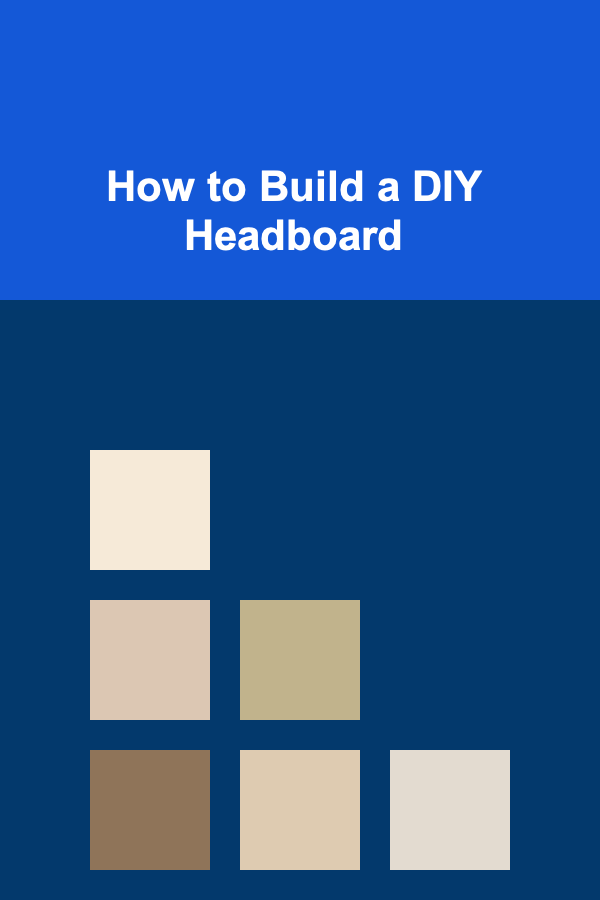
How to Build a DIY Headboard
ebook include PDF & Audio bundle (Micro Guide)
$12.99$8.99
Limited Time Offer! Order within the next:

A headboard is an essential part of any bed's design. It not only adds a touch of style and elegance to your bedroom, but it also provides functionality---offering support while sitting up in bed, whether for reading, watching TV, or just relaxing. While you can easily purchase a pre-made headboard from furniture stores, building your own DIY headboard can be an incredibly rewarding project. It allows you to customize the design, size, and materials to fit your personal taste and the aesthetic of your bedroom.
In this guide, we will walk you through the process of building a DIY headboard. Whether you're an experienced woodworker or a beginner, the steps are simple, cost-effective, and fun. By the end, you'll have a beautiful, personalized headboard that's both practical and stylish.
Materials You'll Need
Before starting your project, it's important to gather all the materials you'll need. Here's a list of basic materials required for building a DIY headboard:
- Wood: Plywood or MDF (Medium-Density Fiberboard) is a popular choice. You can also use reclaimed wood for a rustic look.
- Wooden trim or moulding: This will frame your headboard and add some design detail.
- Fabric or upholstery: If you're making a soft, padded headboard, choose durable fabric such as linen, velvet, or faux leather.
- Foam padding: Use foam if you want a cushioned, soft feel to the headboard.
- Staple gun and staples: To attach the fabric to the headboard.
- Screws and brackets: For securing the headboard to the bed frame.
- Wood screws: For attaching the wood panels and trim.
- Wood glue: For reinforcing connections.
- Sandpaper: To smooth edges and surfaces.
- Paint or stain: To finish the wood if you desire a specific color or finish.
Additionally, you'll need basic tools such as:
- Saws (a jigsaw, circular saw, or hand saw)
- Screwdriver
- Measuring tape
- Clamps
- Staple gun
Step-by-Step Guide to Building a DIY Headboard
Now that you have all the materials, let's dive into the step-by-step process of building your own headboard.
1. Choose Your Design
The first step in building a DIY headboard is to decide on the design. Your headboard should complement your bedroom style and fit the size of your bed. Here are a few design options to consider:
- Upholstered Headboard: A soft, padded headboard with fabric covering. Ideal for a luxurious, cozy feel.
- Wooden Headboard: A minimalist design that uses wood as the main material. This can either be a flat panel or feature patterns and textures.
- Reclaimed Wood Headboard: Perfect for a rustic or farmhouse style, made from old wood planks for a natural, weathered look.
- Modern or Geometric Headboard: Sleek, clean lines that work well in contemporary or modern interiors.
- Decorative Framed Headboard: Featuring moulding or trim around the edges, this design adds a classic and elegant touch.
Once you've decided on your design, measure the width of your bed to determine the dimensions of your headboard. Most headboards are about the same width as the bed, but you can customize it based on your preferences. A queen-size bed typically requires a headboard that's 60 inches wide, while a king-size bed would need a headboard approximately 76 inches wide.
2. Cut Your Wood Panels
Once you have your design and measurements, it's time to cut your wood panels to the desired size. Use a measuring tape to mark the dimensions on your plywood or MDF. If you're using reclaimed wood, ensure that it's free of nails and screws, and then cut it into the desired lengths.
If you're using plywood or MDF, a circular saw or jigsaw is ideal for making straight cuts. When cutting your wood, be sure to wear safety goggles and work gloves, as sawdust and sharp edges can be hazardous.
3. Prepare the Padding (Optional)
If you're creating a padded headboard, you will need to add foam to give it a cushioned feel. Start by cutting the foam to match the dimensions of your headboard. You can purchase foam in sheets from your local fabric or hardware store.
Once the foam is cut, attach it to the wooden panel using spray adhesive or a strong glue. Make sure the foam is centered and completely covers the surface of the headboard. Allow the glue to dry completely before moving to the next step.
4. Add the Upholstery
Next, it's time to add your fabric or upholstery. Lay your fabric flat on a clean surface, ensuring that it's larger than the headboard on all sides---about 3 to 4 inches on each edge.
Place your foam-covered wood panel on top of the fabric, centering it. Pull the fabric tightly over the foam and staple it onto the back of the wood panel. Start at the center of each side, then work your way to the corners, making sure to stretch the fabric tight as you go.
When stapling, use a staple gun and be sure to space the staples evenly to keep the fabric taut. Trim any excess fabric from the edges once it's securely fastened.
5. Attach the Wooden Trim (Optional)
For an added touch of elegance, consider adding wooden trim or moulding around the edges of the headboard. This step is optional, but it can enhance the overall design, making your headboard look more polished.
To add trim, cut your moulding to fit the edges of the headboard. Use wood glue to attach the trim to the front edges of the headboard, and reinforce it with finishing nails or small screws. Sand the edges smooth if necessary, and then paint or stain the trim to match the finish of your wood.
6. Sand and Finish the Wood
If your headboard is made entirely from wood, now is the time to sand it smooth. Use medium-grit sandpaper to smooth out any rough spots, followed by fine-grit sandpaper for a polished finish. If you want a rustic look, you can distress the wood slightly by sanding the edges or using a hammer to create dents and marks.
Once the sanding is complete, it's time to apply the finish. You can either paint the wood or stain it, depending on the look you prefer. If you're going for a clean, modern look, a fresh coat of white paint might be ideal. If you want to showcase the natural grain of the wood, a rich stain will bring out the beauty of the material.
Be sure to apply a couple of coats of paint or stain, allowing each coat to dry completely between applications. Finish with a clear polyurethane sealer for protection.
7. Attach the Headboard to the Bed Frame
After the headboard is complete, it's time to attach it to your bed frame. The easiest way to do this is by using brackets or screws.
First, position the headboard behind your bed. Measure the distance between the top of the bed frame and the wall to ensure the headboard is centered and level. Once you have the headboard in the right position, secure it to the bed frame using brackets, screws, or a metal frame attachment. Some bed frames have pre-drilled holes for attaching a headboard, while others may require you to drill your own.
If you prefer, you can also mount the headboard directly to the wall using wall anchors and screws, especially if you want the headboard to be a focal point in the room. Just be sure to use anchors that are strong enough to support the weight of the headboard.
8. Add Final Touches
Once your headboard is attached, add any final decorative touches to enhance its appearance. Consider adding throw pillows, a duvet, or some bedside lighting to complement your new creation. If your headboard is upholstered, you may want to add a few decorative buttons or studs for extra flair.
9. Enjoy Your New DIY Headboard
With your DIY headboard complete, it's time to sit back and enjoy the finished product. You've added a personal touch to your bedroom, and now you can relax in style and comfort. Whether your headboard is modern, rustic, or classic, it's sure to be a focal point of the room and a source of pride for years to come.
Conclusion
Building a DIY headboard is a rewarding project that allows you to create a custom piece of furniture tailored to your space and style. By following these steps, you can design and construct a headboard that will enhance your bedroom's aesthetic and functionality. Whether you choose a plush, upholstered headboard or a sleek wooden one, the process is straightforward, and the end result will be a beautiful, personalized addition to your home.

How to Make Money Online as an Attorney: 10 Actionable Ideas
Read More
How to Set Up a Family Budget Station at Home
Read More
How to Use the KonMari Method for a Clutter-Free Home
Read More
The Ultimate Guide to Affordable Auto Repairs: Fix Your Car on a Budget
Read More
How to Make Quick Breads (No Yeast)
Read MoreHow to Integrate Income Tracking with Budgeting for Single Parents
Read MoreOther Products

How to Make Money Online as an Attorney: 10 Actionable Ideas
Read More
How to Set Up a Family Budget Station at Home
Read More
How to Use the KonMari Method for a Clutter-Free Home
Read More
The Ultimate Guide to Affordable Auto Repairs: Fix Your Car on a Budget
Read More